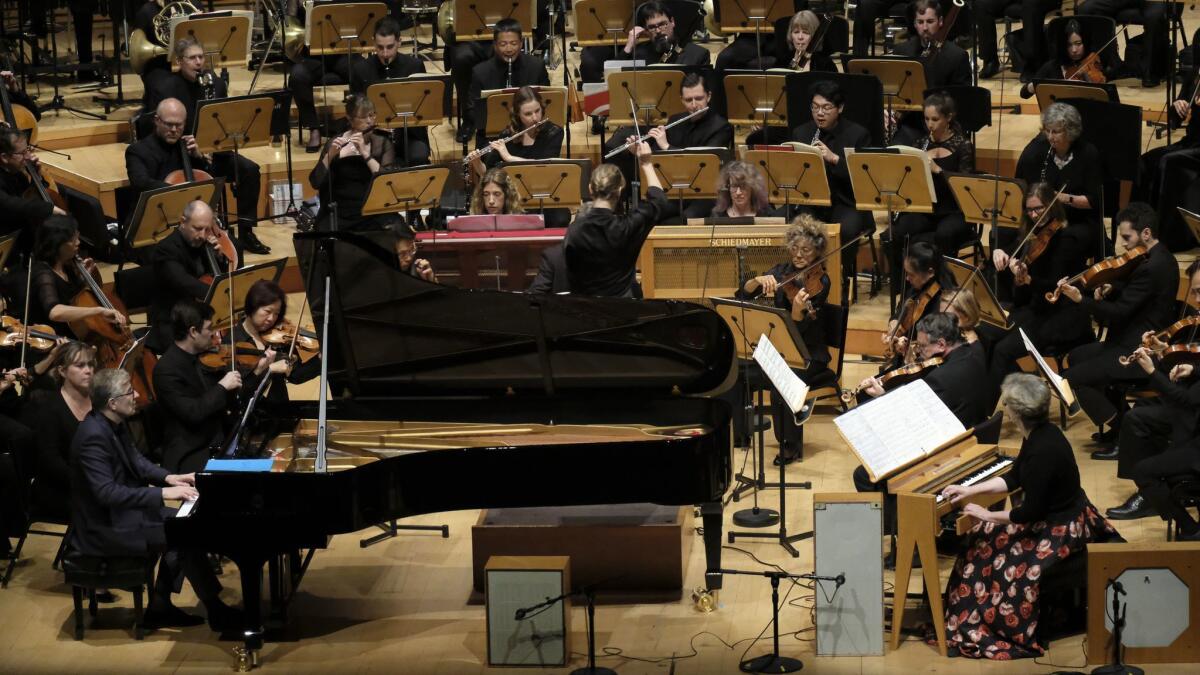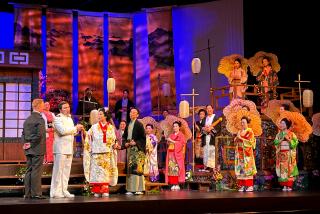Review: After 70 years, Susanna Mälkki proves Messiaen’s ‘Turangalila’ is torrid no more

Exactly when, along with how and why, did Messiaen’s over-the-top “Turangalila” Symphony, which had its premiere in 1949, stop being vulgar? The answers, worthy of a book-length study, require an insight into the changing attitudes about sex and religion, among other things, from popular culture to the avant-garde over the last seven decades.
Roget’s lists of synonyms for vulgar — boorish, crude, trashy, tasteless, decadent, kitschy, etc. — were long ago exhausted in descriptions of this famously excessive 75-minute, 10-movement exposé of lurid eroticism, devout religiosity, epic monumentalism and flower-power delicacy. High modernism, complex rhythmic patterns derived from Indian music, cheesy sci-fi effects and old Hollywood-style love song share musical space in a symphony like none before. Content here determines form, and, for Messiaen, irony is blasphemy.
This much is certain. There was never the slightest hint of vulgarity in the enthralling Los Angeles Philharmonic performance of “Turangalila” that Susanna Mälkki conducted Thursday night at Walt Disney Concert Hall. She took at face value all of Messiaen and made it purposeful. The great glory of “Turangalila” is its vista, which it has taken us pretty much until now to realize is not something so weird that it might be from another planet, but an embracing of the world around us in all its multitude.
Although it wasn’t until 1972 that Michael Tilson Thomas conducted it for the first time in L.A., the score happens to be a specialty of four of the orchestra’s last five music directors, and all have played a significant role in one way or another in de-vulgarizing the “Turangalila.”
André Previn may have never conducted the “Turangalila” while music director of the L.A. Phil, but it was his refined 1977 recording of the work with the London Symphony that first showed that what had once seemed tawdry could be suave. Eight years later, Esa-Pekka Salonen also recorded the symphony in London, this time with the Philharmonia, revealing the score’s startling modernist sensibility as being its determining feature.
By the time Gustavo Dudamel took up “Turangalila” with the L.A. Phil in 2010, the vulgarity wars had been won, and he was able to enthusiastically give the symphony more bang for the buck than it no doubt ever had before, the wow factor now something gladly embraced.
Mälkki’s sensibility has something of the quality of Salonen’s, her Finnish countryman and mentor. And she further emphasized the Finnish angle by devoting the first half of the concert to the U.S. premiere of Kaija Saariaho’s harp concerto, “Trans.”
Yet even that connection between Saariaho and Messiaen has a strong West Coast link. On a remarkable day at the 2000 Salzburg Festival, former L.A. Phil music director Zubin Mehta brought a new degree of “Turangalila” traditionalism by leading the first Vienna Philharmonic performance of the work in the morning. In the evening, two more Californians, conductor Kent Nagano and director Peter Sellars, presented one of the premiere performances of Saariaho’s first opera, “L’Amour de Loin.” Messiaen’s “Turangalila” was meant as a kind of “Tristan und Isolde” for the mid-20th century. Saariaho’s “L’Amour” became another new “Tristan” to welcome in the next century.
A dozen years later, another Angeleno, pianist Gloria Cheng, became the first to really put Saariaho and Messiaen together in her uniquely illuminating recording “The Edge of Light.” It also featured the L.A-based Calder Quartet and booklet notes by Sellars.
Mälkki has now put all this together. Like “Turangalila,” “Trans” is a work of continual transformation. Instrumental textures create musical character. Opposites attract. The harp solo, spectacularly played by Xavier de Maistre, is a creature distinct from the orchestra, which is not unlike the role Messiaen gives to a piano solo in “Turangalila.”
Saariaho too has a way of making you think time stops and then vibrantly making it obvious it doesn’t, something Messiaen pioneered in “Turangalila.” Seductive instrumental surfaces shimmer throughout “Trans,” their insubstantiality never letting you forget they are only for now, not forever.
Mälkki’s “Turangalila” did kind of seem forever. Maybe it was the sheer forcefulness and clarity of the performance. The work has lost neither its audacity not its quaintness, especially in its use of the ondes martenot, the 1928 electronic instrument that is essentially a theremin with a keyboard. Messiaen uses it much of the time to add a viscous voluptuousness to texture of his love music that Cynthia Miller’s ondes martenot helped come as close to sonic pornography as the composer clearly desired. Mälkki let that be, just as she let the dance music achieve its ecstasy.
But she also paid decisive attention to the birdsong of the piano solos, brilliantly conveyed by Jean Yves Thibaudet, as she did to Messiaen’s gamelan-colorful percussion section. Monuments were monuments, made massive by the brass. Clarinets unfolded flowers.
Put it all together, with the ferocity and feeling of the exceptional L.A. Phil, and the symphony stops making sense the way joy stops making sense. Indeed, mapping the progress of “Turangalila” though its 70-year history, the loss of vulgarity appears to closely coincide with joy’s accrual. What does that say about our time that we may be missing?
More to Read
The biggest entertainment stories
Get our big stories about Hollywood, film, television, music, arts, culture and more right in your inbox as soon as they publish.
You may occasionally receive promotional content from the Los Angeles Times.











